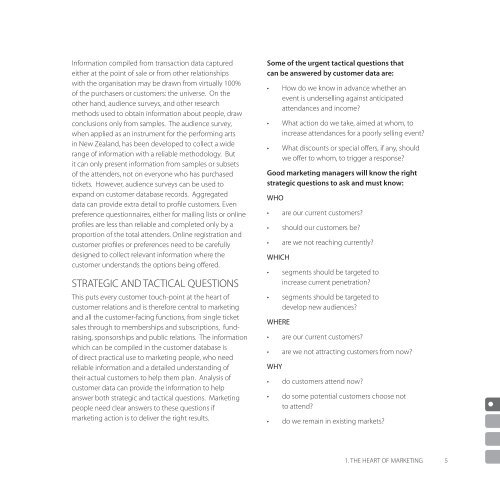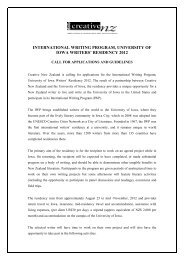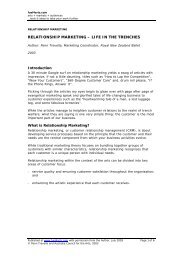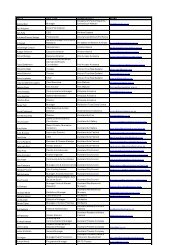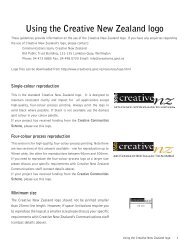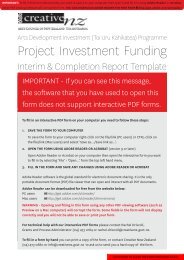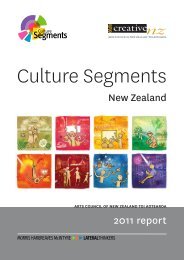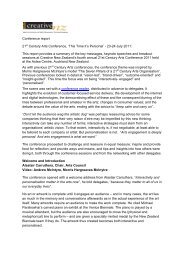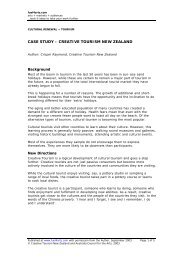FULL HOUSE Turning Data into Audiences - Creative New Zealand
FULL HOUSE Turning Data into Audiences - Creative New Zealand
FULL HOUSE Turning Data into Audiences - Creative New Zealand
You also want an ePaper? Increase the reach of your titles
YUMPU automatically turns print PDFs into web optimized ePapers that Google loves.
Information compiled from transaction data captured<br />
either at the point of sale or from other relationships<br />
with the organisation may be drawn from virtually 100%<br />
of the purchasers or customers: the universe. On the<br />
other hand, audience surveys, and other research<br />
methods used to obtain information about people, draw<br />
conclusions only from samples. The audience survey,<br />
when applied as an instrument for the performing arts<br />
in <strong>New</strong> <strong>Zealand</strong>, has been developed to collect a wide<br />
range of information with a reliable methodology. But<br />
it can only present information from samples or subsets<br />
of the attenders, not on everyone who has purchased<br />
tickets. However, audience surveys can be used to<br />
expand on customer database records. Aggregated<br />
data can provide extra detail to profile customers. Even<br />
preference questionnaires, either for mailing lists or online<br />
profiles are less than reliable and completed only by a<br />
proportion of the total attenders. Online registration and<br />
customer profiles or preferences need to be carefully<br />
designed to collect relevant information where the<br />
customer understands the options being offered.<br />
STRATEGIC AND TACTICAL QUESTIONS<br />
This puts every customer touch-point at the heart of<br />
customer relations and is therefore central to marketing<br />
and all the customer-facing functions, from single ticket<br />
sales through to memberships and subscriptions, fundraising,<br />
sponsorships and public relations. The information<br />
which can be compiled in the customer database is<br />
of direct practical use to marketing people, who need<br />
reliable information and a detailed understanding of<br />
their actual customers to help them plan. Analysis of<br />
customer data can provide the information to help<br />
answer both strategic and tactical questions. Marketing<br />
people need clear answers to these questions if<br />
marketing action is to deliver the right results.<br />
Some of the urgent tactical questions that<br />
can be answered by customer data are:<br />
•<br />
•<br />
•<br />
How do we know in advance whether an<br />
event is underselling against anticipated<br />
attendances and income?<br />
What action do we take, aimed at whom, to<br />
increase attendances for a poorly selling event?<br />
What discounts or special offers, if any, should<br />
we offer to whom, to trigger a response?<br />
Good marketing managers will know the right<br />
strategic questions to ask and must know:<br />
WHO<br />
•<br />
•<br />
•<br />
WHICH<br />
•<br />
•<br />
WHERE<br />
•<br />
•<br />
WHY<br />
•<br />
•<br />
•<br />
are our current customers?<br />
should our customers be?<br />
are we not reaching currently?<br />
segments should be targeted to<br />
increase current penetration?<br />
segments should be targeted to<br />
develop new audiences?<br />
are our current customers?<br />
are we not attracting customers from now?<br />
do customers attend now?<br />
do some potential customers choose not<br />
to attend?<br />
do we remain in existing markets?<br />
1. THE HEART OF MARKETING


